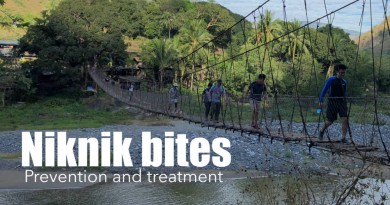Assembling your first aid kit for camping, hiking, and the outdoors
by Gideon Lasco, MD
 This is an article belonging to the ‘climb health‘ category in PinoyMountaineer. Information provided in this article are based on research and are not meant as a substitute to actual medical advice and healthcare.
This is an article belonging to the ‘climb health‘ category in PinoyMountaineer. Information provided in this article are based on research and are not meant as a substitute to actual medical advice and healthcare.
“First aid” is self-explanatory: it comprises the first steps one does to deal with health and medical problems in the absence of medical professionals. Outdoor first aid becomes much more crucial than first aid in urban centers and lowlands where there are hospitals within a matter of minutes. What if you have an allergy at the summit which is 10 hours away from the jumpoff, which in turn is 4 hours away from the nearest town?
Hence, a first aid kit is really important; every team must have one. Your first aid kit is a first line of defense against what I perceive to be the most common health complaints in the outdoors, namely: itchiness, insect bites, abrasions, fever, headache, dizziness, stomache, diarrhea, fractures, among others.
For instructions on what to bring for particular medical conditions such as asthma, diabetes, and hypertension, please consult your doctor. These medications are beyond the scope of this article.
Meanwhile, go get a portable container and place these essential medications, topicals, and materials for a comprehensive first aid kit for the outdoors:
MEDICATIONS
1. Antipyretic (Paracetamol)- for fever and headache
2. Analgesic (Mefenamic Acid) – for pain and headache
3. Antiemetic (Meclizine) – for motion sickness, nausea and vomiting; very useful for nauseatingly long trips across the Cordilleras
4. Antihistamine (Dipphenhydramine/Loratadine) – for itchness, allergic reactions such as hives “pantal-pantal”. Careful though, drowsiness is a common side effect of this drug class.
5. Antidiarrheal (Loperamide) – for diarrhea; not advisable when you’re at home but is useful during hiking trips when you do not have the time to relieve your bowel.
6. Antacid (Maalox) or *H2 Blockers (Ranitidine) – for upset stomach or reflex disease
7. Decongestant (Phenyephrine / Phenypropanolamine) – may be of some benefit with colds that can be caused by high altitude and cold temperatures.
7. Oral Rehydration Salts (OreSol, etc.) – useful for dehydration with can be caused by overfatigue or diarrhea
8. *Antibiotics (Amoxicillin) – not advisable for daytrips or overnighters, but may be useful in very long treks when no other medication is at hand and someone is down with fever. Ideally still precribed by a doctor.
9. *Acetazolamide – a diuretic that is said to be useful for high alititudes (may have little application in the Philippines; consult your doctor)
TOPICALS
1. Sunscreen – Sun creams with SPF15 or higher aren’t just for people who don’t want to get dark; they are medically advisable because they protect the skin from UV rays, not only preventing acute conditions such as sunburns but also long-term complications such as, possibly, skin cancer with prolonged exposure.
2. Insect repellant – This is very useful. Lower elevations would usually have common mosquitoes which can be more than a nuisance when they’re in great number. Some hikers also report that repellants like Off lotion can also protect against limatik.
3. Hydrocortisone cream – Useful for itchiness in the skin, as well as inflammations, especially if localized
4. Calamine lotion – This is useful for itchiness and insect bites, as well as exposure to poison ivy (lipa).
4. Efficasent oil – I recommend this for muscle pains, spasms, and the oil (along with other oils) has an additional effect of protection against the cold
5. Teramycin or any antibiotic ointment – May be applied in wounds to prevent infection or abscess formation
6. Betadine – disinfectant, in case of wounds; otherwise plain soap and water will do.
MATERIALS
1. Adhesive tape (Leukoplast)
2. Adhesive strips (Band-Aid)
3. Bandage – may be used to support sprains and fractures
4. Splints – this may be fashioned out of whatever is available (i.e. branches)
*Those in asterisk are prescription drugs; better consult your doctor
SOME POINTERS:
1. Make sure the medications are labelled properly; you don’t want to take a decongesant for your diarrhea!
2. Alcohol does not offer warmth for the cold – contrary to popular belief. It has little value as a “first aid” substance even though it was used in the past.
3. Make sure your medications are not expired, and are not exposed to water which might affect their potency
4. Make sure that you are aware of your drug allergies, because it is hard to manage it in the mountains
DISCLAIMER
This article is for health advice and information only, and does not intend to replace actual medical consultation. The author cannot be held responsible for any loss, injury, or damage that happens as a result of compliance or non-compliance to this list.






Leave a Reply
3 Comments on "Assembling your first aid kit for camping, hiking, and the outdoors"
You have to customized your first aid kit according your trip.you have to Make sure that your drug allergies, because it is hard to manage it in the mountains
Having First aid kit in our homes and outdoor activities are very advantageous because we can react abruptly if problems occur. If you want to have more knowledge what should be included in your first kits you may visit first aid kits
can i suggest that an article be made on the issue of niknik? i believe its one aspect of philippine mountaineering that is often overlooked, compared to the much-talked-about limatiks.